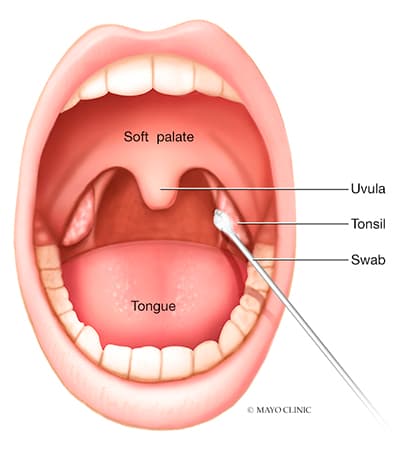
Otolaryngology (ENT)
Tonsillitis
 Tonsillitis is inflammation of the tonsils, two oval-shaped pads of tissue at the back of the throat. Most cases of tonsillitis are caused by infection with a common virus, but bacterial infections may also cause tonsillitis.
Tonsillitis is inflammation of the tonsils, two oval-shaped pads of tissue at the back of the throat. Most cases of tonsillitis are caused by infection with a common virus, but bacterial infections may also cause tonsillitis.
The tonsils are the immune system's first line of defense against bacteria and viruses that enter your mouth. This function may make the tonsils particularly vulnerable to infection and inflammation. However, the tonsil's immune system function declines after puberty — a factor that may account for the rare cases of tonsillitis in adults.
Signs and symptoms
Tonsillitis most commonly affects children between preschool ages and the mid-teenage years. Common signs and symptoms of tonsillitis include:
- A scratchy, muffled, or throaty voice
- Bad breath
- Difficult or painful swallowing
- Enlarged, tender glands (lymph nodes) in the neck
- Fever
- Headache
- Neck pain or stiff neck
- Red, swollen tonsils
- Sore throat
- Stomachache
- White or yellow coating or patches on the tonsils
At-home care
Whether tonsillitis is caused by a viral or bacterial infection, at-home care strategies can promote better recovery. If a virus is the suspected cause of tonsillitis, these strategies are the only treatment.
- Avoid irritants. Keep your home free from cigarette smoke and cleaning products that can irritate the throat.
- Drink adequate fluids. Drinking plenty of water helps to keep the throat moist and prevent dehydration.
- Humidify the air. Use a cool-air humidifier to eliminate dry air that may further irritate a sore throat, or sit for several minutes in a steamy bathroom.
- Offer lozenges. Children older than four can suck on lozenges to relieve a sore throat.
- Provide comforting foods and beverage. Warm liquids — broth, caffeine-free tea, or warm water with honey — and cold treats like ice pops can soothe a sore throat.
- Prepare a saltwater gargle. A saltwater gargle of 1/2 teaspoon (2.5 milliliters) of table salt to 8 ounces (237 milliliters) of warm water can help soothe a sore throat. Gargle the solution and then spit it out.
- Rest and get plenty of sleep.
- Treat pain and fever. Talk to your doctor about using ibuprofen or acetaminophen to minimize throat pain and control a fever. Low fevers without pain do not require treatment.
Tonsillectomy
Surgery to remove tonsils (tonsillectomy) may be used to treat frequent or recurring tonsillitis. Frequent tonsillitis is generally defined as:
- At least seven episodes in the preceding year.
- At least five episodes in the past two years.
- At least three episodes a year in the past three years.
The procedure may also be recommended if:
- A bacterial infection causing tonsillitis doesn’t improve with antibiotic treatment.
- An infection that results in a collection of pus behind a tonsil doesn’t improve with drug treatment or a drainage procedure.
A tonsillectomy is usually done as an outpatient procedure. That means you’ll be able to go home the day of the surgery. An overnight stay is possible if complications arise, if the surgery is done on a young child, or if you have a complex medical condition.